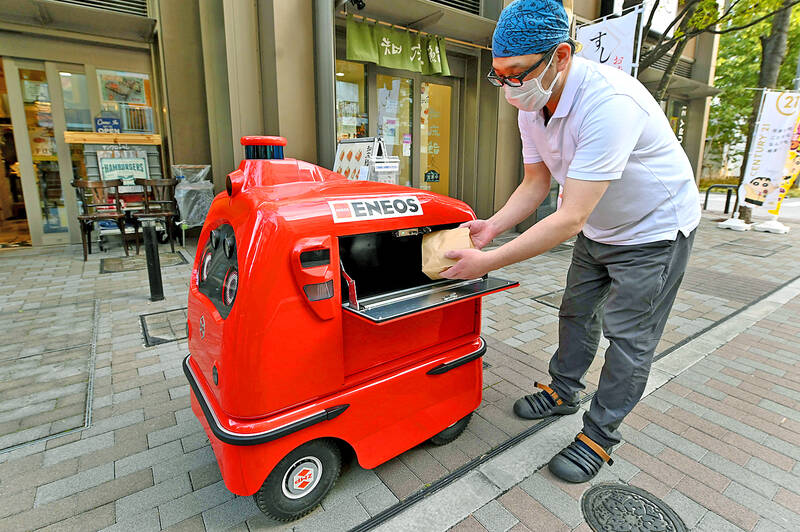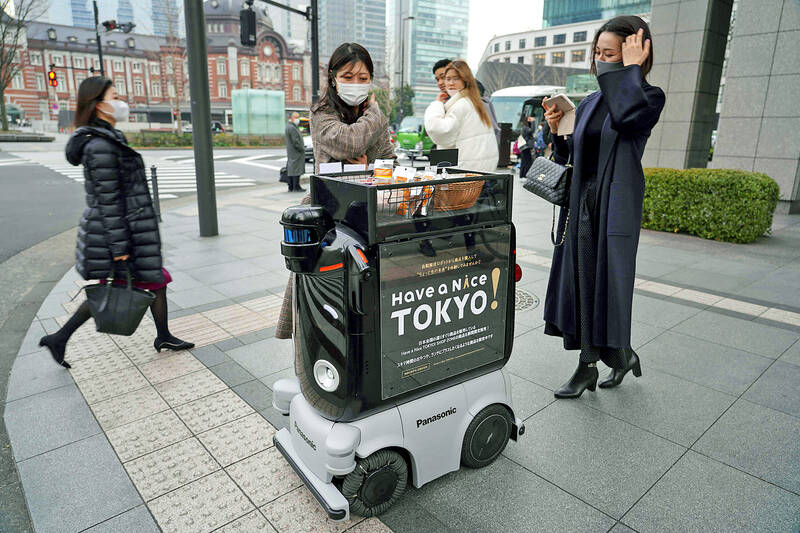“Excuse me, coming through,” a four-wheeled robot chirps as it dodges pedestrians on a street outside Tokyo, part of an experiment businesses hope will tackle labor shortages and rural isolation.
From April, revised traffic laws are to allow self-driving delivery robots to navigate streets across Japan.
Proponents hope the machines could eventually help elderly people in depopulated rural areas gain access to goods, while also addressing a shortage of delivery workers in a country with chronic labor shortages.

Photo: AFP
However, there are challenges to overcome, including safety concerns, said Hisashi Taniguchi, president of Tokyo-based robotics firm ZMP Inc.
“They are still newcomers in human society, so it is natural they’re seen with a bit of discomfort,” he said. “The robots would not be operating entirely alone, with humans monitoring remotely and able to intervene.”
It is important the robots “are humble and lovable” to inspire confidence, Taniguchi said.

Photo: AFP
ZMP has partnered with behemoths such as Japan Post Holdings Co in its trials of delivery robots in Tokyo.
Its “DeliRo” robot aims to look charming, and features big, expressive eyes that can be made teary if pedestrians block its way.
“Every kid around here knows its name,” he said.
There is a serious purpose behind the cuteness.
Japan has one of the world’s oldest populations, with nearly 30 percent of its citizens over the age of 65. Many live in depopulated rural areas that lack easy access to daily necessities.
Labor shortages in its cities and new rules limiting overtime for truck drivers also make it difficult for businesses to keep up with COVID-19 related e-commerce and delivery demands.
“The shortage of workers in transport will be a challenge in the future,” said Dai Fujikawa, and engineer at electronics giant Panasonic Corp, which is trialing delivery robots in Tokyo and nearby Fujisawa.
“I hope our robots will be used to take over where needed and help ease the labor crunch,” he said.
Regulations set a maximum speed of 6kph, meaning the “chances of severe injury in the event of a collision are relatively small,” said Yutaka Uchimura, a professor of robotic engineering at Shibaura Institute of Technology.
If a robot “moves off the sidewalk and collides with a car due to some discrepancy between the preinstalled location data and the actual environment, that would be extremely worrying,” he said.
Panasonic said its “Hakobo” robot can judge autonomously when to turn, as well as detect obstacles, such as construction and approaching bikes, and stop.
One person at the Fujisawa control center simultaneously monitors four robots via cameras and is automatically alerted whenever their robotic charges are stuck or stopped by obstacles, Fujikawa said.
Humans would intervene in such cases, as well as in high-risk areas such as junctions.
Hakobo is programmed to capture and send real-time images of traffic lights to operators and await instructions.
Test runs have so far ranged from delivering medicine and food to Fujisawa residents to peddling snacks in Tokyo with disarming patter such as: “Another cold day, isn’t it? How about some hot drinks?”
Authorities do not believe Japanese streets are soon to be teeming with robots, given the pressure to protect human employment.
“We don’t expect drastic change right away, because there are jobs at stake,” said Hiroki Kanda, an official from the Japanese Ministry of Economy, Trade and Industry, which is promoting the technology.
“The spread of robots will be more of a gradual process, I think,” Kanda said.
Uchimura is aware of the technology’s limitations, and believes rolling the robots out in sparsely populated rural areas first would be safest.
However, firms say that demand in cities is likely to make urban deployment more commercially viable.
Taniguchi hopes to eventually see the machines operating everywhere.
“I think it would make people happy if, with better communication technology, these delivery robots can patrol a neighborhood or check on the safety of elderly people,” he said. “Japan loves robots.”

Semiconductor shares in China surged yesterday after Reuters reported the US had ordered chipmaking giant Taiwan Semiconductor Manufacturing Co (TSMC, 台積電) to halt shipments of advanced chips to Chinese customers, which investors believe could accelerate Beijing’s self-reliance efforts. TSMC yesterday started to suspend shipments of certain sophisticated chips to some Chinese clients after receiving a letter from the US Department of Commerce imposing export restrictions on those products, Reuters reported on Sunday, citing an unnamed source. The US imposed export restrictions on TSMC’s 7-nanometer or more advanced designs, Reuters reported. Investors figured that would encourage authorities to support China’s industry and bought shares

TECH WAR CONTINUES: The suspension of TSMC AI chips and GPUs would be a heavy blow to China’s chip designers and would affect its competitive edge Taiwan Semiconductor Manufacturing Co (TSMC, 台積電), the world’s biggest contract chipmaker, is reportedly to halt supply of artificial intelligence (AI) chips and graphics processing units (GPUs) made on 7-nanometer or more advanced process technologies from next week in order to comply with US Department of Commerce rules. TSMC has sent e-mails to its Chinese AI customers, informing them about the suspension starting on Monday, Chinese online news outlet Ijiwei.com (愛集微) reported yesterday. The US Department of Commerce has not formally unveiled further semiconductor measures against China yet. “TSMC does not comment on market rumors. TSMC is a law-abiding company and we are

FLEXIBLE: Taiwan can develop its own ground station equipment, and has highly competitive manufacturers and suppliers with diversified production, the MOEA said The Ministry of Economic Affairs (MOEA) yesterday disputed reports that suppliers to US-based Space Exploration Technologies Corp (SpaceX) had been asked to move production out of Taiwan. Reuters had reported on Tuesday last week that Elon Musk-owned SpaceX had asked their manufacturers to produce outside of Taiwan given geopolitical risks and that at least one Taiwanese supplier had been pushed to relocate production to Vietnam. SpaceX’s requests place a renewed focus on the contentious relationship Musk has had with Taiwan, especially after he said last year that Taiwan is an “integral part” of China, sparking sharp criticism from Taiwanese authorities. The ministry said

US President Joe Biden’s administration is racing to complete CHIPS and Science Act agreements with companies such as Intel Corp and Samsung Electronics Co, aiming to shore up one of its signature initiatives before US president-elect Donald Trump enters the White House. The US Department of Commerce has allocated more than 90 percent of the US$39 billion in grants under the act, a landmark law enacted in 2022 designed to rebuild the domestic chip industry. However, the agency has only announced one binding agreement so far. The next two months would prove critical for more than 20 companies still in the process